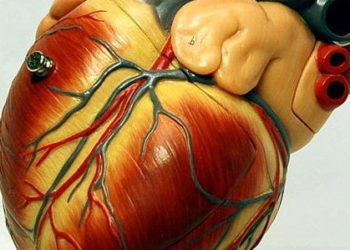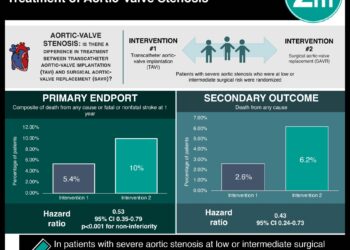Study hints at causal link between lipoprotein(a) and calcific aortic stenosis
Feb 7th – NEJM – Researchers found and replicated an association between a polymorphism in the LPA gene and aortic valve calcification, a precursor to more serious valve disease.
[tabs tab1=”2MM Rundown” tab2= “2MM Full Report”]
[tab]
Image: PD
1. Researchers found and replicated an association between a polymorphism in the LPA gene and aortic valve calcification, a precursor to more serious valve disease.
2. The evidence suggests a causal relationship between the LPA polymorphism and aortic calcification, mediated by increased lipoprotein(a) levels.
This study suggests that lipoprotein(a) has a causal role in the pathogenesis of calcific aortic stenosis. Consequently, niacin and other agents that lower lipoprotein(a) levels could be investigated for benefits in the context of aortic valve calcification. The identification of the rs10455872 polymorphism in LFA might also be useful to identify persons at risk for calcific aortic stenosis.
Another interesting aspect of the study was the use of a biological process (calcification) for phenotyping, rather than a clinical diagnosis. Clinical diagnoses may represent a heterogeneous set of underlying pathogenic mechanisms, which reduces the likelihood of finding associated genetic signals. This study’s success lends credence to its phenotyping strategy.
Although the rs10455872 polymorphism was tested and verified in some non-white populations, the use of only white Europeans in the discovery population is a limitation of the study. Other polymorphisms may be relevant in other populations. In general, the dearth of data from non-white populations is a constraint for such studies.
Click to read the study in NEJM
[/tab]
[tab]
Image: PD
1. Researchers found and replicated an association between a polymorphism in the LPA gene and aortic valve calcification, a precursor to more serious valve disease.
2. The evidence suggests that there is a causal relationship between the LPA polymorphism and aortic calcification, mediated by increased lipoprotein(a) levels.
This [genome-wide association] study: Genotype and phenotype data from three large cohort studies were used to identify polymorphisms associated with aortic valve calcification, as identified via CT scan. A polymorphism in the LPA gene was identified and then tested in additional multi-ethnic cohorts. It was found to be associated with aortic valve calcification in all populations tested except Chinese Americans.
The LPA gene encodes apolipoprotein(a), a component of lipoprotein(a). The authors found that the LPA polymorphism was correlated with lipoprotein(a) levels, and that lipoprotein(a) levels were correlated with aortic valve calcification. Importantly, after adjustment for lipoprotein(a) levels, the association between the polymorphism and aortic valve calcification was no longer significant, suggesting a causal role for lipoprotein(a) levels.
In sum: This study suggests that lipoprotein(a) has a causal role in the pathogenesis of calcific aortic stenosis. Consequently, niacin and other agents that lower lipoprotein(a) levels could be investigated for benefits in the context of aortic valve calcification. The identification of the rs10455872 polymorphism in LFA might also be useful to identify persons at risk for calcific aortic stenosis.
Another interesting aspect of the study was the use of a biological process (calcification) for phenotyping, rather than a clinical diagnosis. Clinical diagnoses may represent a heterogeneous set of underlying pathogenic mechanisms, which reduces the likelihood of finding associated genetic signals. This study’s success lends credence to its phenotyping strategy.
Although the rs10455872 polymorphism was tested and verified in some non-white populations, the use of only white Europeans in the discovery population is a limitation of the study. Other polymorphisms may be relevant in other populations. In general, the dearth of data from non-white populations is a constraint for such studies.
Click to read the study in NEJM
By Tomi Jun and Mitalee Patil
More from this author: Peginasetide non-inferior to EPO for chronic kidney disease patients not on dialysis [PEARL Trials], Video surveillance sheds light on causes of falls in the elderly, [In the News] Extended tamoxifen regimen reduces mortality for subset of breast cancer, [Researcher Comment] Whole-genome sequencing helps halt MRSA bacterial outbreak, [In The News] Modest protection conferred by malaria vaccine in phase 3 trial, [Physician Comment] Multiple sclerosis: Anti-cancer drug beats current first-line treatment in phase 3 trial, A molecular link between sleep deprivation and insulin resistance, A phase I trial of neural stem cells in a disease of myelination shows promising results, Diagnostic exome sequencing in persons with severe intellectual disability finds new candidate genes, HPV vaccine associated with minimal adverse effects, Four different types of breast cancer revealed based on molecular data, Acupuncture helpful for chronic pain: new meta-analysis [Arch Intern Med.]
© 2013 2minutemedicine.com. All rights reserved. No works may be reproduced without written consent from 2minutemedicine.com. Disclaimer: We present factual information directly from peer reviewed medical journals. No post should be construed as medical advice and is not intended as such by the authors or by 2minutemedicine.com. PLEASE SEE A HEALTHCARE PROVIDER IN YOUR AREA IF YOU SEEK MEDICAL ADVICE OF ANY SORT. Content is produced in accordance with fair use copyrights solely and strictly for the purpose of teaching, news and criticism. No benefit, monetary or otherwise, is realized by any participants or the owner of this domain.
[/tab]
[/tabs]




